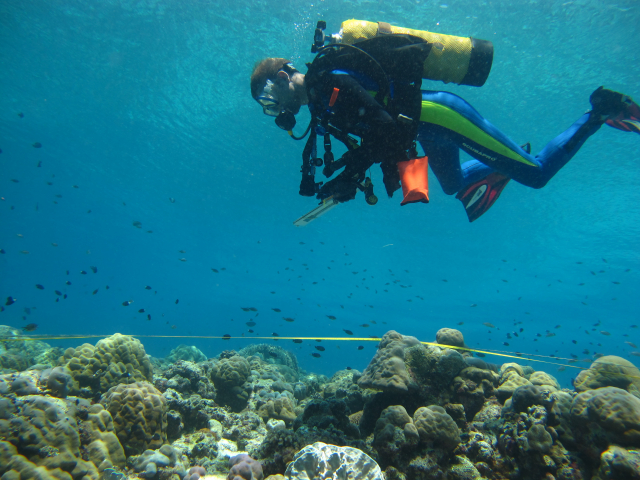17/04/2020 | In a study published this week (17 April 2020) in the scientific journal Science, researchers investigate the question of whether and how socio-economic and ecological goals can be achieved simultaneously through protective measures for coral reefs. An international team of 38 scientists compiled a unique data set from around 1800 reef sites worldwide and simulated the effects of various management approaches. Sebastian Ferse, coral reef ecologist at the Leibniz Centre for Tropical Marine Research (ZMT) in Bremen, also participated in the study.
Tropical coral reefs provide a livelihood for around 500 million people. However, especially along densely populated coasts, they are exposed to a variety of problems caused by humans. Overfishing, pollution from waste or sewage and destruction through coastal development are just a few of these.
There are now more than 2800 protected areas worldwide that restrict or completely prohibit the use of reef resources. The motivation for setting up protection measures can vary - in many places the aim is to preserve reef biodiversity or to support fishing, but in some cases it is also to protect certain ecosystem functions.
Keeping reef conservation areas functioning is associated with great financial and human effort and depends on the acceptance of the coastal inhabitants to whom the reefs provide an income. It must therefore be carefully considered whether such an effort is worthwhile and likely to succeed under the conditions prevailing at a given site.
For more than a decade, researchers led by Joshua Cinner of James Cook University, Australia have been collecting extensive data on the socio-economic conditions, environment and ecological status of reefs at more than 1800 tropical reef sites worldwide. They focused on three representative management objectives: the biomass of large fish, the grazing potential of parrotfish, and the diversity of specific reef fish traits such as their food source, home range and schooling behaviour.
"The biomass of the larger fish is an indication of the value of a reef for the nutrition of the population," explains Sebastian Ferse. "Parrotfish fulfill an important function for the reproduction of corals. They scrape surfaces free of algae and thereby provide space for coral larvae to settle. The diversity of traits in turn is a dimension of biodiversity and a measure of the resilience of an animal community to negative impacts".
In order to determine the human influence on the reefs, the researchers also recorded data on socio-economic characteristics of each site, such as population density, the development status of the respective country and the distance and accessibility of markets. Finally, the protection status of the reefs was also noted when they were located in a marine protected area.
With these data the scientists fed a model that calculated how management measures affect the three parameters fish biomass, parrotfish grazing potential and trait diversity. The model showed that the effectiveness of conservation measures varies considerably depending on the context and the objectives.
The results are partly sobering. For example, where there is strong human influence, even very restrictive protection measures, so-called "no take zones", achieve only a low fish biomass, while in reefs with little human influence the biomass is high even without protected areas. For the other parameters studied, there was little difference between very strict or less strict rules in meeting management objectives.
"With our extensive dataset, we can assess under which circumstances it is worth investing resources in conservation measures and what effects coastal managers can realistically expect from such measures," says Ferse. "National and international protection programmes can thus better focus on specific objectives and set priorities".
Publication
Cinner, J.E., Zamborain-Mason, J., Gurney, G.G., Graham, N.A.J., MacNeil, M.A., Hoey, A.S., Mora, C., Villéger, S., Maire, E., McClanahan, T.R., Maina, J.M, Kittinger, J.N., Hicks, C.C., D’agata, S., Huchery, C., Barnes, M.L., Feary, D.A., Williams, I.D., Kulbicki, M., Vigliola, L., Wantiez, L., Edgar, G.J., Stuart-Smith, R.D., Sandin, S.A., Green, A.L., Beger, M., Friedlander, A.M., Wilson, S.K., Brokovich, E., Brooks, A.J., Cruz-Motta, J.J., Booth, D.J., Chabanet, P., Tupper, M., Ferse, S.C.A., Sumaila, U.R., Hardt, M.J., Mouillot, D. (2020). Meeting fisheries, ecosystem function, and biodiversity goals in a human dominated world. Meeting fisheries, ecosystem function, and biodiversity goals in a human dominated world. Science 368, pp. 307-311. DOI: 10.1126/science.aax9412.





